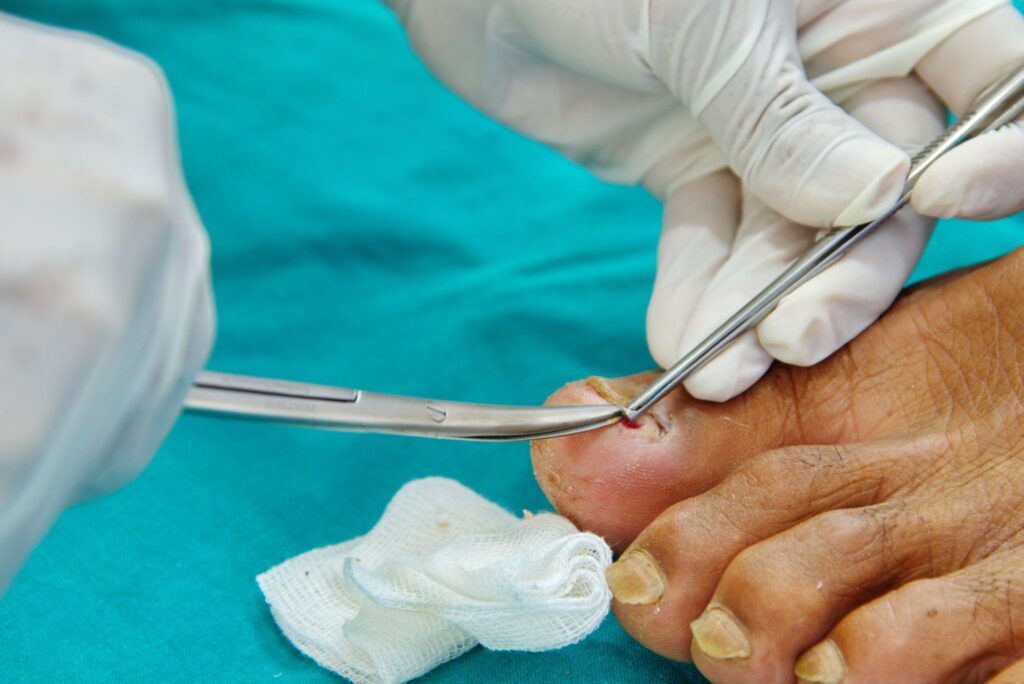Ingrown Nail Surgery
Dermatology

What are ingrown toenails?
An ingrown toenail occurs when the top corner or side of your toenail grows into the flesh next to it. It happens most commonly on your big toe.
Common causes of ingrown toenails include:
- Wearing shoes that are too tight around your toe
- Cutting your toenails too short or with too much of a curve
- Toe or toenail injury
- Toenail naturally grows into a curve
Many ingrown toenails can be successfully treated with home care. But if you have complications, such as a skin infection, or if you get a lot of ingrown toenails, surgery may help. People with diabetes or other conditions that affect the foot may be more likely to need surgery.
What is ingrown toenail surgery?
To prepare you for surgery, your doctor will first clean and numb your toe with an anesthetic injection. This can be quite uncomfortable. A snug elastic band may be applied to the area near where your toe joins your foot. They may put a wedge under your nail to hold up the ingrown section.
Once you’re prepped, the doctor will use scissors and special tools to separate your toenail from the bed, making a vertical cut from the ingrown side down to the cuticle. They’ll then remove the cut section. If necessary, the entire nail may be removed, particularly if both sides of your nail are ingrown.
Your doctor will use either a heated electrical device called a cautery or an acidic solution such as phenol or trichloroacetic acid to disrupt the nail matrix from which your nail grows. This stops your nail from bleeding. It also means that section of your nail likely won’t regrow. If it does regrow, your nail may look differently than it did before surgery.
Finally, your doctor will typically apply a bandage covered with petroleum jelly to your toe.
Does it hurt?
Ingrown toenails can be painful, especially if you press on or around the nail.
Some people report that the anesthetic injection before surgery can be painful. But after the injection takes effect and the numbness sets in, you should be comfortable during the procedure.
You might have pain after surgery once the numbing medication wears off. This is common and can be treated with over-the-counter pain relievers. If these don’t work, talk to your doctor.
Ingrown toenail surgery aftercare
For the first day or two after surgery, you should rest your foot and limit activity. Keep it elevated when you’re sitting.
Your doctor will give you wound care and follow-up instructions. Follow these closely. This will help prevent infection. If necessary, you can take over-the-counter pain relievers for discomfort.
You might also be prescribed oral antibiotics if your toenail was already infected. Follow your doctor’s instructions about how to take these.
Wear open-toed or loose-fitting shoes for about two weeks after surgery. This gives your toe room to heal. After 24 hours, your toe can be kept clean by running warm soapy water over it and patting it dry. Keep it covered until fully healed with a nonstick dressing.
You’ll be able to return to normal activities after a few days, but avoid running and other strenuous activity for about two weeks.
Ingrown toenail surgery prognosis
Ingrown toenail surgery is generally safe and effective. If you have a partial toenail removal, your nail may grow back in approximately three to four months. If you had your toenail totally removed, regrowth can take up to a year. The nail that grows back will be thinner than it was before. There’s also a good chance that it won’t grow back and your toenail bed will heal fine without it.
However, there are potential complications, such as infection, which is possible after any surgery. Your doctor will give you wound care instructions to help prevent infection.
While uncommon, it’s also possible for the doctor to damage deeper parts of the nail bed during surgery. This could cause drainage and poor healing.
Even after surgery, your toenail can become ingrown again. Sometimes this is because the new nail can grow in curved. An ingrown toenail can also come back if you continue wearing poorly fitting shoes, or if your toenail naturally grows in a curved direction.
Common symptoms of ingrown toenails include:
- Pain around your toenail edges
- Buildup of fluid and thickening in the skin around your toenail
- Redness and swelling around your toenail
- Infection with draining pus around the toenail
- Meso therapy
- Microneedling
- Mole / Wart Removal
- TCA Peel
- Vitiligo Surgery
- Scar Removal
- Psoriasis Treatment
- Fungal Infection
- Acne Scar Removal
- Cyst Removal
- Ear Lobe Repair
- Ingrown Nail Surgery
- Dermal Fillers
- Botox Treatment
- Stretchmark Removal
- Laser Skin Resurfacing
- Laser Peel
- Laser Hair Removal
- Fat Reduction
- Tattoo Removal



